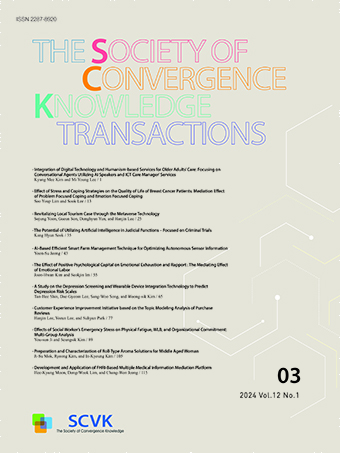Research Article
Abstract
References
Information
본 논문에서는 영상 품질에 대한 신뢰성을 확보하기 위해 색상 및 블러 특징정보 공간변환 기반의 무 기준 영상 품질 평가 방법을 제안한다. 영상데이터의 활용분야가 증가함에 따라 데이터의 양도 급증하였으며 영상 데이터의 품질은 데이터의 활용 결과에도 큰 영향을 미치기 때문에 사전에 고품질의 영상을 분류할 수 있는 단계가 반드시 필요하다. 기존에 제안된 방법들은 단순히 품질평가 점수가 높거나 낮을 때 영상의 품질이 좋음을 의미하지만 품질이 좋은 영상과 왜곡된 영상을 분류하기에는 어려움이 존재한다. 따라서 본 논문에서는 영상 품질 평가를 위해 가장 많이 사용되는 4개의 데이터 셋과 DMOS 정보를 이용하여 품질의 신뢰성이 낮은 왜곡 영상을 분류하는 방안을 제안함으로써 기존의 문제점을 해결하고자 한다. 분류 성능의 정확도를 분석하기 위해 제안 알고리즘과 기존 영상 품질 평가(IQA) 알고리즘을 동일한 평가 방법으로 비교하였으며, 제안하는 알고리즘이 기존 영상 품질 평가 알고리즘보다 높은 우수성을 보임을 확인하였다.
In this paper, we propose a no-reference image quality assessment algorithm based on spatial transformation of color and blur feature information in order to secure the reliability of the quality. As a field of application of image data increased, the amount of data also increased rapidly. In addition, since the quality of image data has a great influence on the result, it is necessary to classify high-quality images in advance. Existing methods simply mean that the quality of the image is good when the score of image quality assessment is high or low. However, there is a difficulty in classifying images as having good or bad quality. Therefore, we try to solve the problems of the existing algorithms by proposing an algorithm to classify distortion images with low quality reliability, and use four data sets of CSIQ, KADID, LIVE, TID2013 and DMOS, which are known most. In order to analyze the accuracy of classification performance, this method was applied equally to the existing methods and compared, and the proposed method was shown to be higher than that of the existing methods.
- 고종국, 배유석, 박종열, 박경, "영상 빅데이터 분석기술 동향", 전자통신동향분석, 제29권 제4호, pp.21-29, 2014.
- 김재생, "빅데이터 분석 기술과 활용사례", 한국콘텐츠학회지, 제12권 제1호, pp.12-20, 2014.
- 김동완, "빅데이터의 분야별 활용사례", 동아대학교 경영문제연구소, 제34권, pp.39-52, 2013.
- C. H. Lee, "Data Quality Assessment Procedure Manual," KDB, pp. 1-204, 2009.
- 이상광, 유원영, 서영호, "영상 화질평가 기술동향", 전자통신통향분석, 제27권 제3호, pp.83-91, 2012.
- H. R. Sheikh, A. C. Bovik, and L. Cormack, "No-Reference Quality Assessment Using Natural Scene Statistics:JPEG2000", IEEE Transactions on Image Processing, Vol. 14, No. 11, pp. 1918-1927, 2005.https://doi.org/10.1109/TIP.2005.854492PMid:16279189
- S. A. Golestaneh, and K. Kitani, "No-Reference Image Quality Assessment via Feature Fusion and Multi-Task Learning", Computer Vision and Pattern Recognition, pp. 1-10, 2020.
- D. Chen, Y. Wang, and W. Gao, "No-Reference Image Quality Assessment: An Attention Driven Approach", IEEE Transactions on Image Proccesing, Vol. 29, pp. 6496-6506, 2020.https://doi.org/10.1109/TIP.2020.2990342PMid:32386153
- K. Y. Lin, and G. Wang, "Hallucinated-IQA: No-Reference Image Quality Assessment via Adversarial Learning", Computer Vision Foundation, pp. 732-741, 2018.https://doi.org/10.1109/CVPR.2018.00083PMCid:PMC5834795
- J. J. M. Escobar, O. M. Matamoros, I. L. Reyes, R. T. Padilla, and L. C. Hernandez, "Defining a No-Reference Image Quality Assessment by Means of the Self-Affine Analysis", Multimedia Tools and Applications, pp. 1-16, 2021.
- X. Chen, Q. Zhang, M. Lin, G. Yang, and C. He, "No-Reference Color Image Quality Assessment: From Entropy to Perceptual Quality", EURASIP Journal on Image and Video Processing, pp. 1-14, 2019.https://doi.org/10.1186/s13640-019-0479-7
- E. C. Larson, and D. M. Chandler, "Most Apparent Distortion: Full-Reference Image Quality Assessment and the Role of Strategy", Journal of Electronic Imaging, Vol. 19, No. 1, 2010.https://doi.org/10.1117/1.3267105
- H. Lin, V. Hosu, and D. Saupe, "KADID-10k: A Large-Scale Artificially Distorted IQA Database", 2019 Eleventh International Conference on Quality of Multimedia Experience, pp. 1-3, 2019.https://doi.org/10.1109/QoMEX.2019.8743252
- Z. Wang, A. C. Bovik, H. R. Sheikh, and E. P. Simoncelli, "Image Quality Assessment: From Error Visibility to Structural Similarity", IEEE Transactions on Image Processing, Vol. 13, No. 4, pp. 600-612, 2004.https://doi.org/10.1109/TIP.2003.819861PMid:15376593
- H. R. Sheikh, M. F. Sabir, and A. C. Bovik, "A Statistical Evaluation of Recent Full Reference Image Quality Assessment Algorithms", IEEE Transactions on Image Processing, Vol. 15, No. 11, pp. 3440-3451, 2006.https://doi.org/10.1109/TIP.2006.881959PMid:17076403
- N. Ponomarenko, L. Jin, O. Ieremeiev, V. Lukin, K. Egiazarian, J. Astola, B. Vozel, K. Chehdi, M. Carli, F. Battisti, and C. C. J. Kuo, "Image Database TID2013: Peculiarities Results and Perspectives", Signal Processing: Image Communication, Vol. 30, pp. 57-77, 2015.https://doi.org/10.1016/j.image.2014.10.009
- A. Mittal, A. K. Moorthy, and A. C. Bovi, "No-Reference Image Quality Assessment in the Spatial Domain", IEEE Transactions on Image Processing, Vol. 21, No. 12, 2012.https://doi.org/10.1109/TIP.2012.2214050PMid:22910118
- A. Mittal, R. Soundararajan, and A. C. Bovik, "Completely Blind Image Quality Analyzer", IEEE Signal Processing Letters, Vol. 20, No. 3, pp. 209-212, 2019.https://doi.org/10.1109/LSP.2012.2227726
- N. Venkatanath, D. Praneeth, Bh. M. Chandrasekhar, S. S. Channappayya, and S. S. Medasani, "Blind Image Quality Evaluation Using Perception Based Features", In Proceedings of the 21st National Conference on Communications (NCC), pp. 1-6, 2015.https://doi.org/10.1109/NCC.2015.7084843
- L. Zhang, L. Zhang, and A. C. Bovik, "A Feature-Enriched Completely Blind Image Quality Evaluator", IEEE Transactions on Image Processing, Vol. 24, No. 8, pp. 2579-2591, 2015.https://doi.org/10.1109/TIP.2015.2426416PMid:25915960
- A. McAndrew, "A Computational Introduction to Digital Image Processing", Second Edition, CRC Press, 2016.https://doi.org/10.1201/b19431
- R. C. Gonzalez, and R. E. Woods, "Digital Image Processing", Third Edition, Prentice-Hall, 2008.https://doi.org/10.1117/1.3115362
- S. L. Lee, and C. C. Tseng, "A Back Lighting Color Enhancement Method Using Color Saturation and Image Fusion", Proc. of IEEE ICCE, pp. 23-24, 2015.https://doi.org/10.1109/ICCE-TW.2015.7216870
- S. L. Lee, and C. C. Tseng, "Image Enhancement Using DCT-Based Matrix Homomorphic Filtering Method", Proc. of IEEE APCCAS, pp. 1-4, 2016.https://doi.org/10.1109/APCCAS.2016.7803880
- C. C. Tseng, and S. L. Lee, "A Weak-Illumation Image Enhancement Method Using Homomorphic Filter and Image Fusion", 2017 IEEE 6th Global Conference on Consumer Electonics (GCCE), pp. 1-2, 2017.https://doi.org/10.1109/GCCE.2017.8229192
- A. Ajmal, C. Hollitt, M. Frean, and H. AI-Sahaf, "A Comparison of RGB and HSV Colour Spaces for Visual Attention Models", 2018 International Conference on Image and Vision Computing New Aealand, pp. 1-6, 2018.https://doi.org/10.1109/IVCNZ.2018.8634752PMid:29656055
- F. Crete-Roffect, T. Dolmiere, P. Ladret, and M. Nicolas, "The Blur Effect: Perception and Estimation with a New No-Reference Perceptual Blur Metric", In SPIE, 2007.https://doi.org/10.1117/12.702790
- L. T. Jolliffe, and J. Cadima, "Principal Component Analysis: A Review and Recent Developments", Philosophicla Transactions of the Royal Society A, Vol. 374, Issue 2065, 2016.https://doi.org/10.1098/rsta.2015.0202PMid:26953178PMCid:PMC4792409
- Publisher :The Society of Convergence Knowledge
- Publisher(Ko) :융복합지식학회
- Journal Title :The Society of Convergence Knowledge Transactions
- Journal Title(Ko) :융복합지식학회논문지
- Volume : 9
- No :2
- Pages :49-69
- DOI :https://doi.org/10.22716/sckt.2021.9.2.014




 The Society of Convergence Knowledge Transactions
The Society of Convergence Knowledge Transactions







